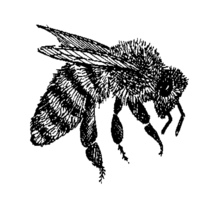 | Back to e-WV
| Back to e-WV
 The West Virginia Encyclopedia
The West Virginia Encyclopedia
 | Back to e-WV
| Back to e-WV
 The West Virginia Encyclopedia
The West Virginia Encyclopedia

Insects are small, six-legged animals with no internal skeletons. Of the approximately 1.5 million named species of animals, about 1 million are insects. In North America alone, there are about 100,000 species of insects. Although there are no official counts of West Virginia insect species, estimates place the number at 20,000 or higher.
One reason for the success of insects is that they can live in a wide range of habitats. West Virginia’s mountain topography creates a diversity of habitat types, which has resulted in a wide variety of flora and fauna. This can be seen in a group of beetles known as the snail hunting ground beetles. The mountainous region of the eastern United States is the world center of diversity for this insect, with much of the diversity localized in the mountains of West Virginia.
Many plants and animals exist in West Virginia at the northern or southern limits of their range. Much of this is due to the fact that, as a result of ancient glacial events, high-altitude regions of the southern Appalachian Mountains in West Virginia resemble northern boreal forests. Insects that live in these areas are normally found only in much more northern latitudes. The Atlantis fritillary and pink-edged sulphur butterflies can be found associated with blueberry plants (their host) in parts of the state such as Dolly Sods. These two butterfly species are much more common in northern parts of the continent. A number of other relict insect species have been described in West Virginia.
Although harmful insects make up less than 1 percent of the classified species, insects widely are recognized for the negative roles they play in the environment. Some insects carry diseases that may affect humans, other animals, and plants. Mosquitoes and some other insects inflict irritating bites, even when no disease is transmitted. Still others are quick to sting. Many insects are agricultural pests, such as the eastern tent caterpillar. This caterpillar is just one of several native moth species that can be especially destructive to fruit trees. Another agricultural pest, the periodical cicada or 17-year locust, emerges every 17 years to reproduce, causing potentially extensive damage to valuable timber trees.
Many of the most harmful agricultural pests are insects that have been introduced to the state. Among these is the gypsy moth, which was intentionally introduced to the U.S. by a private citizen in Massachusetts in 1869 for experiments in silk production. The gypsy moth has made its way into West Virginia. Both state and federal programs now work to slow the spread and minimize the effects of this pest, which can destroy trees, especially valuable hardwoods.
Despite the harmful roles some species can play in human endeavors, insects are major and important parts of the ecosystem in West Virginia, as they are everywhere. Insects are a necessary component of the food chains of a number of bird, fish, and other animal species. Fishermen exploit this, their ‘‘flies’’ mimicking different life stages of various insect species.
Many of the state’s agricultural crops depend on insects, such as the honeybee, for pollination. The honeybees in turn provide a valuable product in their honey, now averaging about 1.2 million pounds a year. In 2002, the legislature made the honeybee the official state insect of West Virginia.
Written by Amy Donaldson Arnold
Allen, Thomas J. The Butterflies of West Virginia and their Caterpillars. Pittsburgh: University of Pittsburgh Press, 1997.
Stephenson, Steven L., ed. Upland Forests of West Virginia. Parsons: McClain, 1993.
Constantz, George. Hollows, Peepers, and Highlanders. Missoula, MT: Mountain Press, 1994.
Wagner, David L., et al. Caterpillars of Eastern Forests. Morgantown: United States Department of Agriculture, 1997.